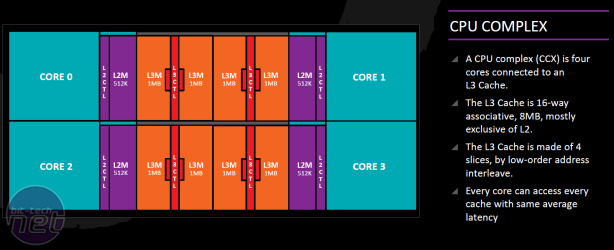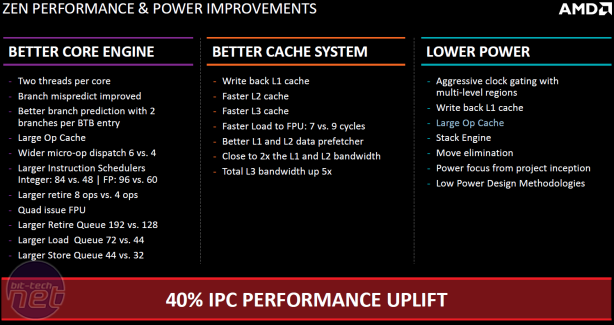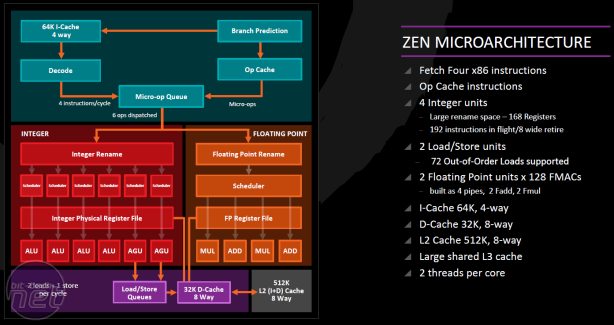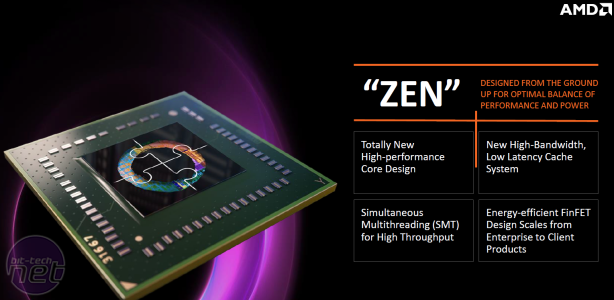
AMD had revealed more details about the architectural improvements behind its Zen CPUs.
During a worldwide press briefing, AMD offered an insight into the new Zen architecture and why it's claiming it will be up to 40 percent faster than its previous generation CPUs.
Speaking in the briefing, design engineer Mike Clark spoke at length about the company's new 14nm CPUs, which he claims have received a focus on power efficiency from day one - something that has continued throughout their years of development.
To incorporate this and their claimed 40 percent increase in instructions per clock, Zen has been designed from the ground up, as previous architectures could not meet these demands, especially as AMD wants to use the architecture across a range of products - in anything from low-power notebooks to beefy, multi-core desktop CPUs.
Here, the likes of Excavator and Jaguar couldn't be tweaked to meet the targets AMD's architecture design team set in terms of efficiency and the ability to scale across a range of products including the performance desktop processor 'Summit Ridge' range of 14nm CPUs.
This is exciting news as one could say that despite small rays of hope with the likes of Bulldozer, AMD hasn't been competitive in the performance CPU area since Intel's release of the Core architecture in 2006, instead building on a design that's now a decade old. Indeed, AMD has been touting some performance numbers showing that, clock for clock, an eight-core version of a Zen CPU was able to keep pace with Intel's Broadwell-E Core i7-6900K, although the latter is clocked higher by default.
One assumes that four and six-core parts, should they arrive, will be able to dish out some much-needed competition in the mainstream, doing battle with Intel's Skylake CPUs and low-end Broadwell-E parts.
As well as high power draw and heat, instructions per clock are one area that AMD has been lagging behind, and by some quite significant margins. A 40 percent increase would be very welcome and is apparently down to the full redesign, which sees the number of instruction schedulers rise from 128 to 192, better branch prediction, wider Op cache and greater cache bandwidth (up to five times the L3 cache bandwidth and the L2 cache is faster too).
To keep the power consumption as low as possible, Zen CPUs will have aggressive clock gating with multi-level regions, which have enabled AMD to offer its claimed 40 percent increase in instructions per clock but at similar energy per cycle - same power, more performance - compared to Excavator. We're hoping to see Zen review samples some time between now and Christmas, but we're sure you'll agree that competition will be very welcome in the CPU market.
During a worldwide press briefing, AMD offered an insight into the new Zen architecture and why it's claiming it will be up to 40 percent faster than its previous generation CPUs.
Speaking in the briefing, design engineer Mike Clark spoke at length about the company's new 14nm CPUs, which he claims have received a focus on power efficiency from day one - something that has continued throughout their years of development.
To incorporate this and their claimed 40 percent increase in instructions per clock, Zen has been designed from the ground up, as previous architectures could not meet these demands, especially as AMD wants to use the architecture across a range of products - in anything from low-power notebooks to beefy, multi-core desktop CPUs.
Here, the likes of Excavator and Jaguar couldn't be tweaked to meet the targets AMD's architecture design team set in terms of efficiency and the ability to scale across a range of products including the performance desktop processor 'Summit Ridge' range of 14nm CPUs.
Click to enlarge
This is exciting news as one could say that despite small rays of hope with the likes of Bulldozer, AMD hasn't been competitive in the performance CPU area since Intel's release of the Core architecture in 2006, instead building on a design that's now a decade old. Indeed, AMD has been touting some performance numbers showing that, clock for clock, an eight-core version of a Zen CPU was able to keep pace with Intel's Broadwell-E Core i7-6900K, although the latter is clocked higher by default.
Click to enlarge
One assumes that four and six-core parts, should they arrive, will be able to dish out some much-needed competition in the mainstream, doing battle with Intel's Skylake CPUs and low-end Broadwell-E parts.
Click to enlarge
As well as high power draw and heat, instructions per clock are one area that AMD has been lagging behind, and by some quite significant margins. A 40 percent increase would be very welcome and is apparently down to the full redesign, which sees the number of instruction schedulers rise from 128 to 192, better branch prediction, wider Op cache and greater cache bandwidth (up to five times the L3 cache bandwidth and the L2 cache is faster too).
Click to enlarge
To keep the power consumption as low as possible, Zen CPUs will have aggressive clock gating with multi-level regions, which have enabled AMD to offer its claimed 40 percent increase in instructions per clock but at similar energy per cycle - same power, more performance - compared to Excavator. We're hoping to see Zen review samples some time between now and Christmas, but we're sure you'll agree that competition will be very welcome in the CPU market.

MSI MPG Velox 100R Chassis Review
October 14 2021 | 15:04












Want to comment? Please log in.